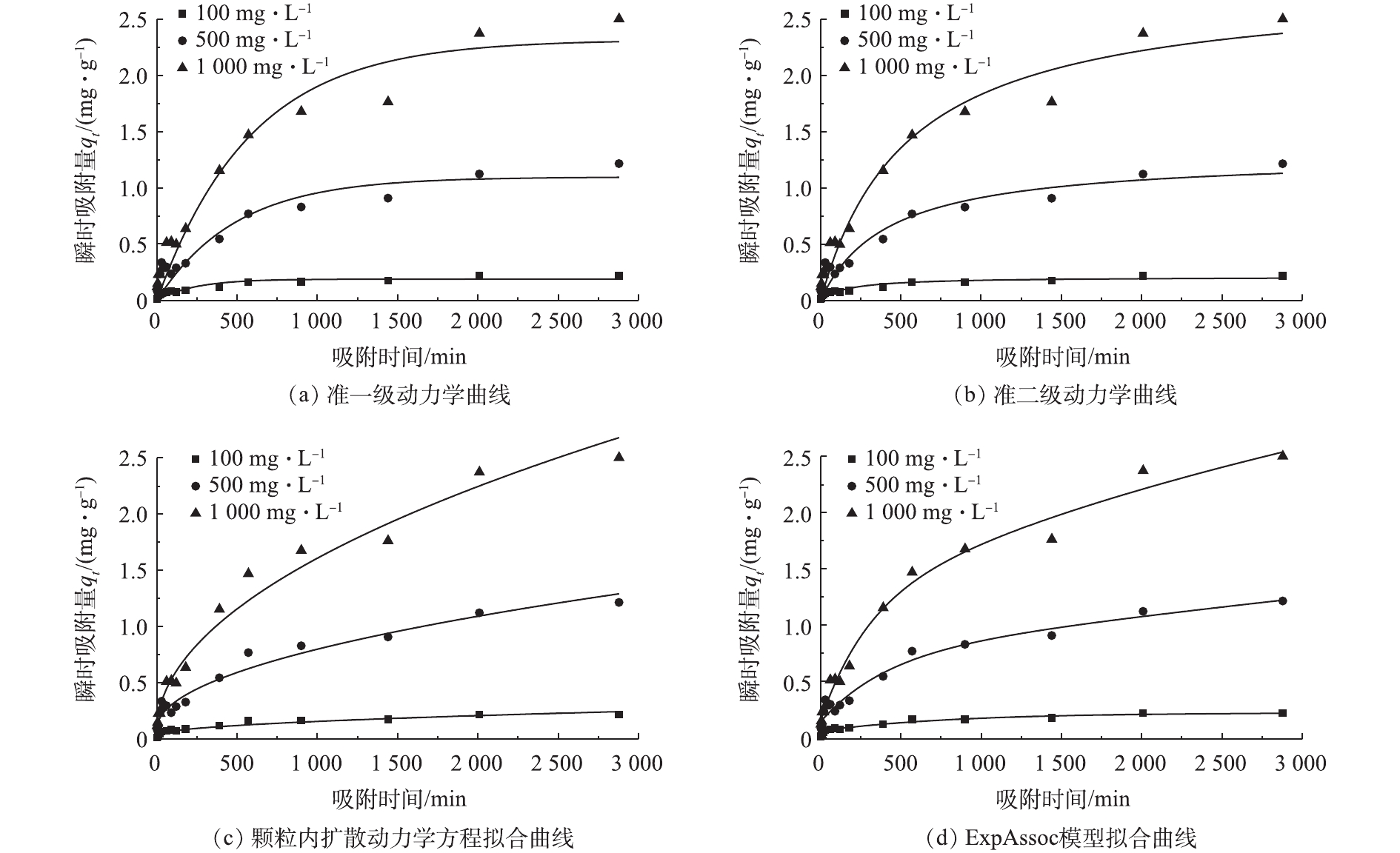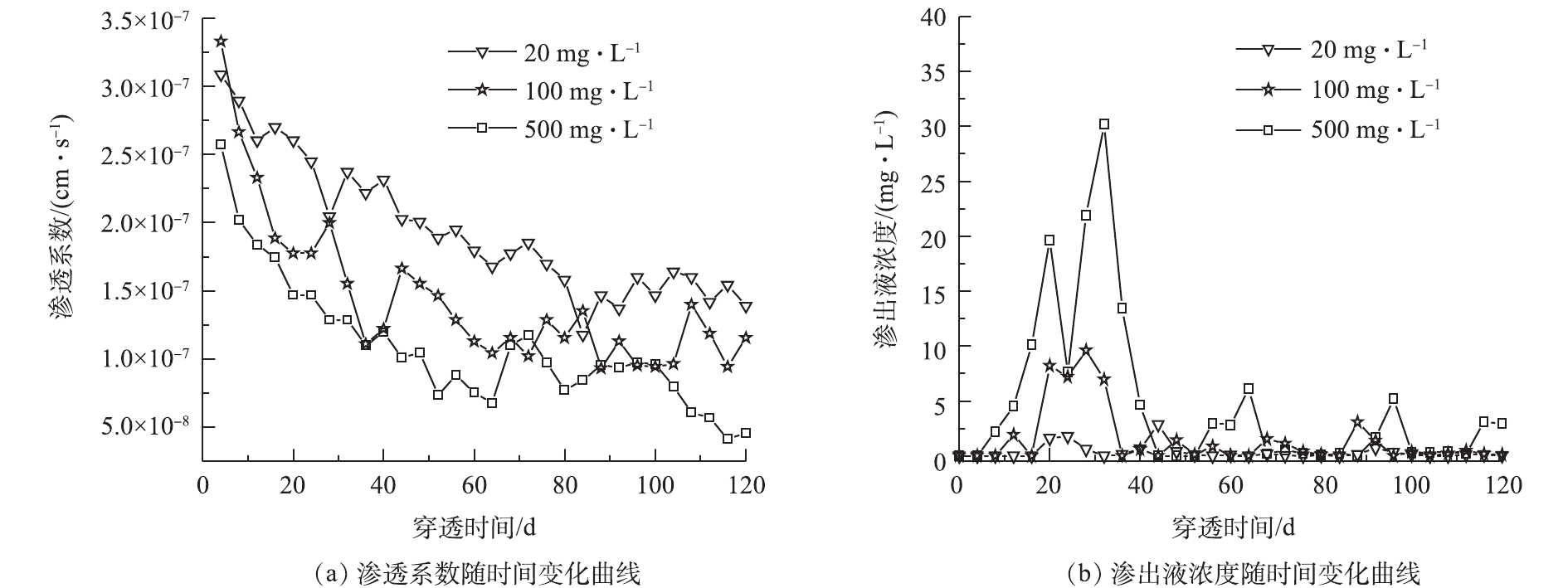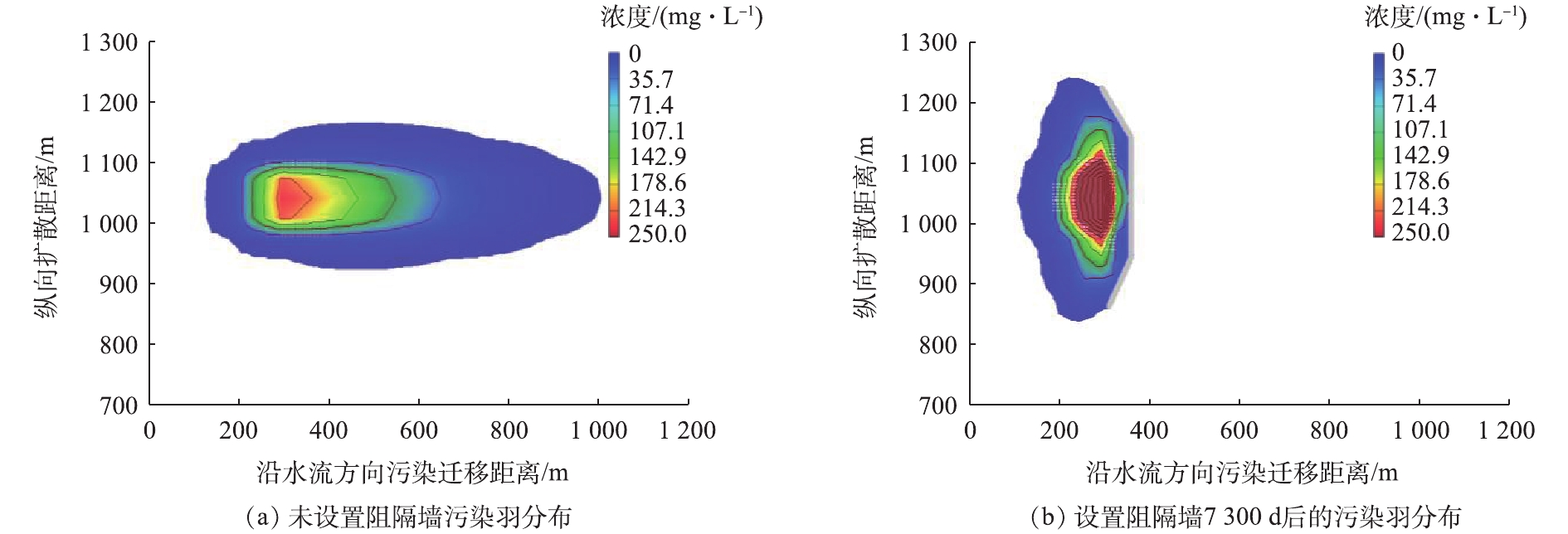-
随着我国工业原料需求的增大,矿山开采导致了大量的环境污染问题[1]。离子型稀土矿区的氨氮污染的出现,是由于在原地浸析采矿时,硫酸铵、碳酸铵等浸矿剂溶液及含氨氮的浸出液大量流失,造成矿区地下水和地表水氨氮超标[2],并致使矿区及周边地表土壤结块,流域水质恶化严重,大量草本植物枯死,影响地区动植物的生长[3]。目前,离子稀土矿区氨氮污染防治措施主要有控制浸出过程污染、废水处理技术、人工防渗假底、污染阻隔技术等[4-5]。刘斯文等[6]通过添加沸石等材料来固定土壤中氨氮;朱健玲等[7]针对开采过程中产生的高浓度氨氮废水,开展了接触膜脱氨工艺的中试实验。近年来,阻隔墙技术常用于垃圾填埋场、重金属污染、矿山污染等[8-9]。在现有的阻隔墙技术的研究中,范日东[10]研究发现,重金属污染作用下,土-膨润土竖向隔离屏障材料渗透系数低及化学相容性较好;EKREM[11]研究发现,硅灰的加入会降低黏土复合防渗层的表面开裂速度、压缩率和膨胀率,可将硅灰用于改性黏土;黄琴琴等[12]对粉煤灰-膨润土阻隔墙控制地下水中镉污染进行了研究,发现其对镉的阻控较好。但是,目前对离子型稀土矿氨氮污染的阻控研究较少。
阻隔墙对污染物的阻控主要受孔隙度影响,虽然土-膨润土阻隔材料渗透系数小,但抗压强度小[13-14]。有研究[15-16]表明,采用膨润土、硅灰、水泥等材料改良黏土材料可以提高其抗渗性能及力学强度。但目前阻隔材料研究多集中在复合材料选择、配比及对渗透速率的影响上,对阻隔材料对氨氮污染的阻隔机理及效果研究[12, 17-18]较少。本研究采用硅灰改性土-膨润土作为阻隔墙材料,将其用于离子型稀土矿氨氮污染的阻控。通过测定渗透系数、抗压强度,得到阻隔墙材料的最佳配比,使用XRD对改性前后阻隔墙材料的成分进行分析,并考察该阻隔材料对氨氮的吸附效果和氨氮在阻隔墙内的穿透能力。最后,利用Visual MODFLOW数值模拟,对比设置阻隔墙前后氨氮的污染扩散范围,为硅灰改性土-膨润土阻隔墙材料阻控离子型稀土矿氨氮污染提供参考。
-
硫酸铵((NH4)2SO4)、氯化铵(NH4Cl)、纳氏试剂(HgI2-KI-NaOH)、酒石酸钾钠(C4H4O6KNa·4H2O)、盐酸(HCI)、氢氧化钠(NaOH)。
-
坍落度测定仪(天津市津阳建筑仪器厂);数显酸度计(PE-28型,上海梅特勒-托利多仪器有限公司);渗透系数测定仪(TST-55型,苏州赢安养仪器有限公司);微机控制压力试验机W(HY-1000型,上海华龙仪器有限公司);X射线衍射(德国布鲁克D8ADVANC);可见分光光度计(上海美谱达仪器有限公司);水浴恒温振荡器(SHA-B,常州国宇仪器制造有限公司)。
-
原位土取自成都理工大学金工基地,将取回的黏土去除石质成分,烘干后粉碎,过200目筛;膨润土为人工钠基膨润土,粒径为0.025~0.048 mm;水泥为复合硅酸盐/425水泥;硅灰粒径为0.005~0.011 mm。
膨润土与蒸馏水按10∶100比例混合均匀,搅拌24 h,使膨润土充分水化。将硅灰和黏土按照质量比0∶1、1∶3、1∶4、1∶6、1∶7、1∶8、1∶9、1∶10、1∶13、1∶14、1∶16、1∶19加入容器中,同时加入总干物质的量的8%水泥,混合均匀后加入膨润土浆液。
-
含水率的确定按照(ASTM. C143M-15)中坍落度实验中的方法[19],采用标准的坍落度筒,初始含水率在50%左右,取3组硅灰与黏土质量比差别较大的配比进行实验,再根据坍落度范围,确定含水率进行后续实验。试样中膨润土掺量,即膨润土与混合土样之比[20]可由式(1)确定。
式中:wb为膨润土掺量;wi为各坍落度点对应的含水率。
渗透系数的测定使用61.8 mm×40 mm渗透仪环刀制取材料试样,养护7 d后,放入变水头渗透仪,测定渗透系数,渗透系数[21]按照式(2)计算。
式中:KT为变水头渗透系数,cm·s−1;a为测压管断面积,cm2;A为试样截面面积,cm2;t1、t2为分别为测压管水头的测定前后时间,s;h1、h2为测定前后的水头,cm。
抗压强度的测定是将试样倒入直径61.8 mm、高40 mm圆柱体试模中[22],养护7 d后,用微机控制压力实验机得到最大压应力,根据式(3)计算得到抗压强度[22]。
式中:qu为抗压强度,MPa;P为单轴应变力,N;A为垂直方向上试样面积,mm2。
根据最佳渗透性能及抗压强度选择最佳配比的实验组进行后续实验。
-
在进行吸附动力学实验时,配制100、500、1 000 mg·L−1浓度的氨氮溶液200 mL,将试样放入其中静置,分别在0~2 880 min不同时间节点内取样,测定溶液中氨氮的瞬时浓度,并按式(4)计算瞬时吸附量[22]。
式中:Qt为试样对氨氮的瞬时吸附量,mg·g−1;C0为吸收前氨氮质量浓度,mg·L−1;Ct为吸收后氨氮质量浓度,mg·L−1;V为氨氮溶液的体积,mL;m为的试样质量,g。
在进行吸附热力学实验时,配制10组浓度在25~250 mg·L−1之间且不同浓度梯度的硫酸铵溶液,根据吸附平衡时间,分别在15、25、35 ℃下进行吸附热力学实验。吸附完成后,测定吸附平衡后溶液中氨氮的浓度,并计算平衡吸附量[23]。
-
在进行穿透实验时,配制
NH+4 浓度为20、100、500 mg·L−1的溶液,注入渗透系数测定仪水箱内,将水头高度设置为1 m。定时收集渗透仪流出液,测量其流出液容量及氨氮浓度[14-16]。利用Visual MODFLOW数值模拟研究氨氮在阻隔墙作用下的迁移,得到改性土-膨润土阻隔墙对氨氮污染的阻控效果。采用有限差分网格法求解污染物三维迁移方程,求出污染物在各网格结点上不同时刻的浓度,用数值模拟预测阻隔墙和地下水中溶质随时间和空间的分布变化[24-25]。
-
采用X射线衍射仪分析改性前后阻隔墙材料中相应结晶物质的组成变化[26]。
-
MALUSIS等[27]和YEO等[28]分别以125 mm和100 mm为目标坍落度,胡晓瑾[20]以110 mm为坍落度所对应含水率。本研究以100~125 mm坍落度范围为目标坍落度。根据配比中选择硅灰和黏土比例为1∶3、1∶10和1∶19的试样,试样含水率越大,其坍落度也越大,当含水率为67.80%时,实验的3组试样坍落度在100~125 mm坍落度范围内。因此,选择67.80%的含水率为试样的坍落度进行后续实验,通过式(1)计算试样中最佳膨润土掺量,结果为6.78%。
土-膨润土泥浆防渗墙一般情况下强度小于0.1 MPa,渗透系数一般为10−6~10−7 cm·s−1[12-14, 16-18]。李松[29]发现,当硅灰掺量高于10%时,强度提高,硅灰对抗渗性能的影响最大;同时,渗透系数与强度之间存在强度越高、渗透系数越低的关系。不同组别的渗透系数及抗压强度如表1所示。可以看出,硅灰填充体系中的孔隙的存在,减小了渗透系数。当黏土的含量减少时,又会导致渗透系数增高。因此,在硅灰、黏土比例为1∶10时渗透系数达到最低。
由于硅灰具有火山灰效应和微粒充填效应,硅灰可与水泥的水化产物发生二次水化反应,形成胶凝产物,填充水泥石结构,使阻隔墙材料骨架连接性能增强,提高力学强度[11, 15]。
当硅灰、黏土配比为1∶10时,渗透系数为2.360×10−7 cm·s−1,抗压强度为0.896 MPa,达到最佳实验效果,并且均能满足污染场地阻隔要求[8, 16, 22],因此,选择此配比进行后续实验研究。
-
改性前后阻隔材料的XRD图谱见图1。改性土-膨润土阻隔材料主要是由石英(SiO2)和长石(CaO·Al2O3·SiO2)组成[26]。改性后的图谱中,在2θ=29.32°处有方解石(CaCO3)特征峰,CaCO3可以提高阻隔材料的力学强度[15];同时,在2θ=30.59°、35.03°处,出现硅酸钙水合物(CaAl2Si2O7·4H2O)特征峰,CaAl2Si2O7·4H2O可以填充阻隔材料内部的孔隙,提高阻隔墙材料的防渗性能[11, 26]。因此,推测硅灰改性阻隔材料后,提高了阻隔材料密度、降低孔隙率。
-
为了准确评估吸附过程的动力学行为,拟合实验绘制了吸附量与时间的Qt-t曲线。然后分别用准一级模型(式(5))、准二级动力学模型(式(6))、颗粒内扩散模型(式(7))和非线性最小二乘法拟合(NFLS)ExpAssoc模型(式(8))进行拟合[30-32]。
式中:qt为t时刻氨氮的吸附量,mg·g−1;k1为准一级动力学速率常数,min−1;qe为试样吸附氨氮的平衡吸附量,mg·g−1;k2为准二级动力学常数,mg·(g·min)−1;kd为内扩散速率常数,mg·(g·min0.5)−1;Ci为截距,与边界层厚度有关;A1、A2、t1、t2为ExpAssoc动力学模型方程常数。
试样在3组不同浓度中的氨氮吸附过程均表现为:在0~500 min内快速吸附,之后逐渐达到平衡。这说明在此时间段内,氨氮被吸附在试样表面,而随着吸附反应的进行,逐渐变缓,最后趋于平衡。吸附氨氮过程的时间与瞬时吸附量的关系及曲线拟合结果见图2,具体拟合参数见于表2。结果显示,最好的拟合模型为非线性最小二乘法ExpAssoc模型[30],其拟合得到的3条氨氮吸附动力学曲线R2>0.97。根据ExpAssoc模型的拟合方程,在吸附时间为1 440 min时吸附量达到90%。同时,3组曲线的准二级动力学方程(R2>0.90)较准一级动力学方程(R2>0.84)拟合度更高,故准二级动力学更适用于描述该吸附过程。准二级动力学模型,是假设由化学吸附所控制,并基于吸附量与吸附位点数量有关而建立的模型[31-32]。可以看出,阻隔墙材料对氨氮的吸附过程以化学吸附为主。
-
为了准确评估吸附过程的热力学行为,将吸附曲线根据Langmuir等温线方程(式(9))、Freundlich等温线方程(式(11))和D-R等温线方程[22, 31-32](式(12))进行拟合。
式中:qe为吸附平衡时氨氮的浓度,mg·g−1;Ce为吸附平衡时氨氮浓度,mg·L−1;KL为Langmuir模型参数,L·mg−1;qm为饱和吸附量,mg·g−1;RL为分离因子,它的大小可以判断是否有利于吸附污染物;KF为Freundlich模型参数,L·mg−1;n为Freundlich模型参数;β为与吸附自由能相关的常数;ε为Polanyi势能;R为理想气体常数,取值8.314 J·(mol·K)−1;T为绝对温度,K;E为平均吸附自由能。
根据吸附动力学结果,设置吸附热力学实验时间为1 440 min。吸附平衡后,随着氨氮浓度的增加,吸附等温线的斜率有逐渐变小的趋势。由此可见,随着吸附温度的升高,试样对氨氮的吸附量逐渐减小。隋淑梅等[23]研究得到,在较低温度下,黏土对氨氮的吸附量越大,吸附速度越小,吸附平衡时间越长,平衡吸附量越大。拟合结果如图3所示,具体拟合参数见于表3。结果显示,拟合得到的Freundlich吸附等温线模型R2>0.95,但是根据拟合结果得到n值大于1,因此,Freundlich吸附等温线模型不合适用于该吸附过程[30]。同时,3组曲线的Langmuir等温模型(R2≥0.962)较D-R等温模型(R2≥0.762)拟合度更高,故Langmuir等温模型更适用于描述该吸附过程。由D-R等温模型拟合结果得到β,通过式(14)计算出3组不同温度的平均吸附自由能E>16 kJ·mol−1,说明吸附体系是化学吸附过程[3]。Langmuir等温模型拟合曲线得到的参数KL,通过式(10)计算出分离因子RL,得到0<RL<1,这表明试样对氨氮的吸附时有利的[23];在温度相同时,初始浓度越高,RL越小,这表明试样对低浓度的氨氮更有亲和力;KL值随着温度的升高反而降低,这说明该吸附是放热过程[31-32]。
-
试样在120 d内的渗透系数变化见图4(a)所示。可以看出:前期试样的渗透性能变化幅度较大,后期逐渐趋于稳定;而且,在初始浓度较高时,渗透系数越小,变化幅度也较小,3组不同浓度的实验得到的渗透系数在逐渐减小。这是由于试样加入的硅灰中含有大量SiO2和Al2O3[11],在水化过程中会产生氧化钙、可溶性石膏、硅铝酸盐等,可与渗透液中H+发生反应中和酸性,并生成CaSO4,利于形成胶凝产物,填充试样的内部结构,从而使阻隔墙材料渗透系数变小[15, 29]。但是,渗透系数变化均在5×10−8~3.5×10−7 cm·s−1之间,总体变化相差较小。
120 d内定时测定流出液的氨氮浓度结果如图4(b)所示。可以看出:在10~40 d,浓度较高,变化幅度较大;在40~120 d,浓度较低,变化幅度较小,浓度越高。变化幅度越大。故3组实验在120 d内都未达到穿透浓度[12]。
-
在模拟污染物扩散时,考虑吸附、对流迁移等因素[33],Visual MODFLOW数值模型为空间三维结构,设置其水平和垂直方向的渗透系数相同,即边界条件各向均质同性[24]。考虑到实际场地、水流、水位的改变,设置模型参数为非稳定流地下系统,外界恒定的补给水量,并且不考虑南北的水量交换。同时,污染物以面源的方式向各方向渗漏[34]。其数学表达式[24-25]见式(15)和式(16)。
式中:Ω为模拟区域;K为渗透系数,m·d−1;S为贮水率,m−1;W为源汇项,d−1;P降水入渗量和蒸发量,mg·d−1;(x,y,z)为模型中某点;Г0为边界。
研究区模型在平面剖分为130行和130列,离散为16 900个单元格。东西方向长度为2 000 m;南北方向长度为2 000 m,垂向最大高程为100 m,最小为50 m,相对高差为50 m,土层分为3层,分别为砂层、黄土层、亚黏土层,各土层具体参数[25, 33]见表4。平均降雨量取值为500 mm·a−1,降雨入渗系数取值为0.20。
未设置阻隔墙预测污染羽的分布如图5(a)所示。发生泄漏后,氨氮随着场地下水沿着水流方向发生了明显的迁移,污染羽呈羽状分布[34]。随着时间的推移,污染羽范围不断向下游迁移[24]。当时间为7 300 d时,氨氮的最大迁移距离为881 m。
设置阻隔墙预测7 300 d后污染羽的分布如图5(b)所示。在污染场地设置阻隔墙厚度为1 m,通过对比设置阻隔墙前后氨氮迁移7 300 d后的污染羽,得到阻隔料对场地污染控制的效果。阻隔材料存在吸附阻滞能力和水力阻滞能力,能有效阻隔和控制地下水中氨氮的迁移[13-14]。在阻隔墙左侧,污染羽由中心向四周浓度逐渐降低,这是因为阻隔墙的吸附性能和低渗透性能使得污染物被吸附,并由于受到水力阻滞而存积在阻隔墙内部,造成阻隔墙左侧污染物堆积,随时间的延长,迁移浓度不断升高,但是氨氮未穿透阻隔墙。因此,改性土-膨润土阻隔墙在7 300 d内,在此模拟场地对氨氮的阻控较好。
-
1)硅灰改性土-膨润土改性后,生成的铝硅酸盐与CaCO3分别提高了阻隔墙防渗性能及力学性能。阻隔墙最佳质量配比为硅灰∶土=1∶10,材料最佳含水率为67.80%,渗透系数为2.36×10−9 m·s−1,7 d抗压强度为0.896 MPa。
2)改性阻隔材料对氨氮的吸附动力学过程符合准二级动力学模型,吸附热力学过程符合Langmuir等温模型,说明该吸附过程主要以化学吸附为主,并且该吸附是放热过程。
3)阻隔材料在不同氨氮浓度的穿透下,渗透系数呈逐渐减小的趋势,是试样中硅灰二次水化的结果,且实验期间并未达到穿透浓度。利用Visual MODFLOW数值模拟得到的模型,在污染场地设置阻隔墙7 300 d后,氨氮扩散范围小,并且未穿透阻隔墙,阻控效果较好。
改性土-膨润土阻隔墙阻控离子型稀土矿氨氮污染
Resistance and control of ammonia nitrogen pollution of ionic rare earth ores with modified soil-bentonite barrier
-
摘要: 以土-膨润土为阻隔材料,使用硅灰及水泥对其进行固化改性,研究改性后阻隔墙对离子型稀土矿原地浸矿氨氮污染的阻控效果。通过了解阻隔墙材料的渗透性能、力学性能,并结合阻隔材料对氨氮的吸附效果、穿透效果和数值模拟结果,探讨改性土-膨润土阻隔材料对氨氮污染的阻控性能。结果表明:硅灰改性土-膨润土阻隔材料,最佳质量配比为硅灰∶土=1∶10,最佳含水率为67.80%;改性阻隔材料生成的铝硅酸盐提高了阻隔墙防渗性能,渗透系数为2.36×10−9 m·s−1;CaCO3提高了材料的力学性能,使抗压强度达到0.896 MPa;改性阻隔材料对氨氮的吸附过程符合准二级动力学模型及Langmuir等温模型。这说明该吸附过程以化学吸附为主,并且该吸附是放热过程。在不同氨氮浓度的穿透下,渗透系数呈逐渐减小的趋势,实验期间并未达到穿透浓度。利用Visual MODFLOW数值模型对阻隔墙的阻控效果进行模拟发现,7 300 d后
NH+4 扩散范围小,未穿透阻隔墙。硅灰改性土-膨润土阻隔墙用于对离子型稀土矿氨氮污染阻控的效果较好。Abstract: In this study, silica fume and cement were used to perform the curing and modification of the barrier material of soil-bentonite, the control effect of modified barrier on ammonia nitrogen pollution caused by in-situ leaching of ionic rare earth ore was investigated. Through analyzing the permeability and mechanical properties of the barrier material, and the adsorption and penetration effects of the barrier material on ammonia nitrogen, as well as the numerical simulation results, the resistance and control properties of the modified soil-bentonite barrier material on ammonia nitrogen pollution were discussed. The results showed that for silica fume modified soil- bentonite barrier material, the optimal mass ratio of silica fume to soil was 1∶10, and the optimal moisture content was 67.80%. The permeability of the barriers was improved by the aluminosilicate yielded in modified barrier material, and the corresponding hydraulic conductivity was 2.36×10−9 m·s−1. CaCO3 improved the mechanical properties of the material and its compressive strength reached 0.896 MPa. The adsorption process of ammonia nitrogen by the modified barrier material conformed to the quasi-second-order kinetic model and the Langmuir isothermal model, which indicated that the adsorption process was dominated by chemical adsorption and exothermic process. Under the penetration of different ammonia nitrogen concentrations, the permeability coefficient gradually decreased, while the penetration concentration was not reached during the experiment. Visual MODFLOW numerical model was adopted to simulate the barriers, and the results indicated that the diffusion range ofNH+4 was small and the barrier wall was not penetrated after 7 300 d simulation runing. The silica fume modified soil- bentonite barrier has a good effect on ammonia nitrogen pollution control in ionic rare earth minerals. -
表 1 不同配比的阻隔墙的渗透系数及力学强度
Table 1. Hydraulic conductivity and mechanical strength of barriers with different ratio
硅灰∶黏土 渗透系数/(cm·s−1) 抗压强度/MPa 硅灰∶黏土 渗透系数/(cm·s−1) 抗压强度/MPa 0∶1 9.824×10−7 0.367 1∶9 3.068×10−7 0.882 1∶3 1.192×10−6 0.942 1∶10 2.360×10−7 0.896 1∶4 9.261×10−7 0.931 1∶13 3.673×10−7 0.690 1∶6 6.681×10−7 0.921 1∶14 4.991×10−7 0.434 1∶7 5.782×10−7 0.917 1∶16 7.560×10−7 0.399 1∶8 3.450×10−7 0.914 1∶19 7.342×10−7 0.373 表 2 氨氮吸附动力学方程拟合模型参数
Table 2. Fitting model parameters of adsorption kinetic equation of ammonia nitrogen
初始浓度C0/(mg·L−1) 准一级动力学 准二级动力学 qe/(mg·g−1) k1/min−1 R2 qe/(mg·g−1) k2/(mg·(g·min)−1) R2 100 0.188 0.004 0.845 0.230 0.028 0.900 500 1.096 0.002 0.895 1.292 0.002 0.919 1 000 2.316 0.002 0.953 2.820 6.565×10−4 0.969 初始浓度C0/(mg·L−1) 颗粒内扩散方程 ExpAssoc模型 Kd/(mg·(g·min0.5)−1) Ci R2 y0 A1 t1 A2 t2 R2 100 0.004 0.033 0.944 6.1×10−4 0.060 10.799 0.161 834.232 0.984 500 0.022 0.093 0.966 0.143 3.782 20 728.860 0.590 407.996 0.972 1 000 0.049 0.071 0.979 0.155 3.008 4 833.499 1.034 292.684 0.988 表 3 氨氮吸附热力学方程拟合模型参数
Table 3. Fitting model parameters of adsorption thermodynamic equation of ammonia nitrogen
反应温度/K Langmuir等温模型 Freundlich等温模型 D-R方程 qm/(mg·g−1) KL/(L·mg−1) R2 1/n KF/(L·mg−1) R2 qm β R2 288.15 5.045 0.004 0.981 0.721 0.047 0.970 1.941 4.324×10−4 0.882 298.15 10.463 0.001 0.962 0.910 0.013 0.959 1.547 5.989×10−4 0.862 308.15 15.092 0.001 0.969 1.123 0.004 0.975 1.230 6.342×10−4 0.762 表 4 模型主要参数
Table 4. Main model parameters
地层 渗透系数/(m·d−1) 重力给水度 有效孔隙度/% X Y Z 砂层 1 1 0.1 0.1 20 黄土层 0.15 0.15 0.015 0.07 9 亚黏土层 1×10−3 1×10−3 1×10−4 0.04 5 -
[1] GUO L Y, CHEN Q K, FANG F, et al. Application potential of a newly isolated indigenous aerobic denitrifier for nitrate and ammonium removal of eutrophic lake water[J]. Bioresource Technology, 2013, 142: 45-51. doi: 10.1016/j.biortech.2013.05.021 [2] 邓振乡, 秦磊, 王观石, 等. 离子型稀土矿山氨氮污染及其治理研究进展[J]. 稀土, 2019, 40(2): 120-129. [3] 杨帅. 离子型稀土矿开采过程中氨氮吸附解吸行为研究[D]. 北京: 中国地质大学, 2015. [4] 赵永红, 张涛, 成先雄. 离子吸附型稀土矿区土壤与水环境氨氮污染及防治技术研究进展[J/OL]. 稀土: 1-9.[2019-10-01]. https://doi.org/10.16533/J.CNKI.15-1099/TF.20200010. [5] 刘松玉, 詹良通, 胡黎明. 环境岩土工程研究进展[J]. 土木工程学报, 2016, 49(3): 6-30. [6] 刘斯文, 黄园英, 韩子金, 等. 离子吸附型稀土矿山土壤生态修复研究与实践[J]. 环境工程, 2015, 33(11): 160-165. [7] 朱健玲, 王瑞祥. 接触膜脱氨法处理离子吸附型稀土矿山氨氮废水的工程实践[J]. 有色金属(冶炼部分), 2017(9): 58-62. [8] 谢云峰, 曹云者, 张大定, 等. 污染场地环境风险的工程控制技术及其应用[J]. 环境工程技术学报, 2012, 2(1): 51-59. doi: 10.3969/j.issn.1674-991X.2012.01.009 [9] QIAN Z, HYUNWOOK C, ADITYA B, et al. Review of the fundamental geochemical and physical behaviors of organoclays in barrier applications[J]. Applied Clay Science, 2017, 142: 2-20. doi: 10.1016/j.clay.2016.11.024 [10] 范日东. 重金属作用下土-膨润土竖向隔离屏障化学相容性和防渗截污性能研究[D]. 南京: 东南大学, 2017. [11] EKREM K. Influence of silica fume on the desiccation cracks of compacted clayey soils[J]. Applied Clay Science, 2009, 43(3/4): 296-302. [12] 黄琴琴, 刘国, 文梅燕, 等. 粉煤灰-膨润土阻隔墙控制地下水中镉污染[J]. 环境工程学报, 2018, 13(2): 1-14. [13] 潘倩. 土-膨润土竖向隔离墙力学行为及其对防污性能影响[D]. 杭州: 浙江大学, 2016. [14] 吕淑清. 土壤-膨润土泥浆墙对污染物的阻截性能及机理研究[D]. 长春: 吉林大学, 2015. [15] 王瑞. 超细粉煤灰高强混凝土性能研究[D]. 合肥: 安徽理工大学, 2018. [16] 周冰. 改性水泥-膨润土垂直阻截墙防渗性能和抗侵蚀能力的研究[D]. 长春: 吉林大学, 2013. [17] XU H, SHU S, WANG S, et al. Studies on the chemical compatibility of soil-bentonite cut-off walls for landfills[J]. Journal of Environmental Management, 2019, 237: 155-162. [18] 徐超, 黄亮, 邢皓枫. 水泥-膨润土泥浆配比对防渗墙渗透性能的影响[J]. 岩土力学, 2010, 31(2): 422-426. doi: 10.3969/j.issn.1000-7598.2010.02.016 [19] American Society of Testing Materials. Standard test method for slump of hydraulic-cement concrete: C143/C143M-15[S]. West Conshohocken, PA: ASTM, 2015. [20] 胡晓瑾. 废旧轮胎胶粉改性土-膨润土竖向帷幕防污性能研究[D]. 武汉: 湖北工业大学, 2017. [21] JOSHI K, KECHAVARZI C, SUTHERLAND K, et al. Laboratory and in situ tests for long-term hydraulic conductivity of a cement-bentonite cutoff wall[J]. Journal of Geotechnical and Geoenvironmental Engineering, 2010, 136(4): 562-572. doi: 10.1061/(ASCE)GT.1943-5606.0000248 [22] 文梅燕. 粉煤灰-膨润土阻截墙控制地下水镉污染的研究[D]. 成都: 成都理工大学, 2018. [23] 隋淑梅, 尹志刚, 姜利国, 等. 考虑地下水温度的土壤吸附氨氮动力学行为研究[J]. 水资源与水工程学报, 2016, 27(3): 217-225. doi: 10.11705/j.issn.1672-643X.2016.03.43 [24] 李平, 卢文喜, 马洪云, 等. Visual MODFLOW在地下水数值模拟中的应用: 以公主岭市黄龙工业园水源地为例[J]. 工程勘察, 2006(3): 24-27. [25] JIA J, TIAN B, LIU C. Visual MODFLOW and its application on groundwater simulation: A case study on Luancheng county of Hebei province[J]. Journal of Agricultural University of Hebei, 2003, 26: 71-78. [26] 郄玥颖, 张鹏, 崔自治, 等. 膨润土改性黄土的强度特性[J]. 河北农业大学学报, 2017, 40(6): 125-128. [27] MALUSIS M A, MANEVAL J E, BARBEN E J, et al. Influence of adsorption on phenol transport through soil-bentonite vertical barriers amended with activated carbon[J]. Journal of Contaminant Hydrology, 2010, 116(1): 58-72. [28] YEO S S, SHACKELFORD C D, EVANS J C. Membrane behavior of model soil-bentonite backfills[J]. Geotechnical and Geo-Environmental Engineering, 2005, 131: 418-429. doi: 10.1061/(ASCE)1090-0241(2005)131:4(418) [29] 李松. 防渗墙塑性混凝土的性能研究[D]. 杨凌: 西北农林科技大学, 2016. [30] 李慧. 氨氮在黄土包气带中吸附解吸特征和影响因素探讨[D]. 西安: 长安大学, 2014. [31] 孙大志. 氨氮在土壤中吸附/解吸的动力学与热力学研究[J]. 华北大学学报(自然科学版), 2007, 8(6): 493-496. [32] 钱吉彬, 杨朗, 张华, 等. 镇江斜发沸石对氨氮的吸附动力学及热力学研究[J]. 环境工程学报, 2011, 5(2): 327-330. [33] PAN J, HAN C Y, KANG R R, et al. Application of Visual MODFLOW to numerical simulation of multi-level groundwater[J]. Advanced Materials Research, 2012, 518-523(12): 4150-4154. [34] 尉鹏翔. Visual Modflow在地下水污染物运移模拟中的应用[J]. 水资源保护, 2011, 27(4): 19-21. doi: 10.3969/j.issn.1004-6933.2011.04.005 -









 下载:
下载:







